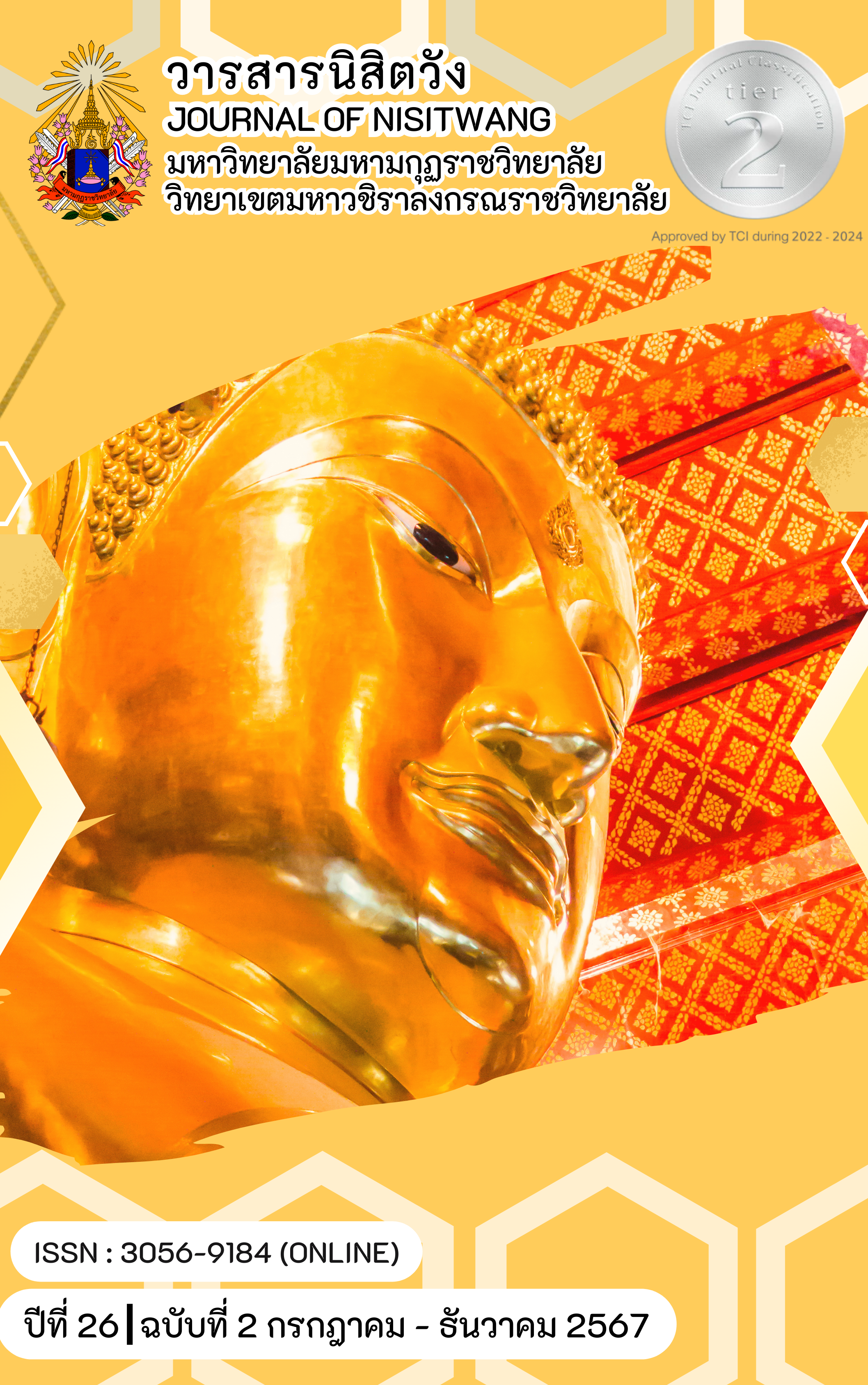DEVELOPING A SET OF COOPERATIVE LEARNING ACTIVITIES TO ENHANCE THAI LANGUAGE COMMUNICATION ABILITIES FOR STUDENTS WHO DO NOT USE THAI AS THEIR MOTHER TONGUE AT THE UPPER PRIMARY LEVEL
Main Article Content
Abstract
The objectives of this research article are 1) to study basic information for developing a cooperative learning activity set to enhance Thai language communication abilities for students who do not use Thai as their mother tongue at the upper primary level, 2) to develop collaborative learning activity sets to enhance Thai language communication abilities for students who do not use Thai as their mother tongue at the upper primary level, 3) compare Thai language communication abilities before and after using collaborative learning activity sets to enhance Thai language communication abilities for students who do not use Thai as their mother tongue at the upper primary level and 4) study students' opinions on cooperative learning activities to enhance Thai language communication abilities for students who do not use Thai as their mother tongue at the upper primary level. The sample group was upper primary school students at Samakkhi Phatthana School under the Chiang Rai Primary Educational Service Area Office 3, Semester 2, Academic Year 2023, 198 people, using the purposive selection method. The research tools include basic document analysis forms for developing activity sets, Cooperative learning activity sets, appropriateness evaluation forms for activity sets, Thai language communication ability tests, and student opinion questionnaires on collaborative learning activities.
Statistics used in research include mean, standard deviation, t-test, content analysis and analytic induction, and followed by narrative description.
The research findings are as follows :
- Basic information, It consists of Thai language communication problems of students who do not use Thai as their mother tongue, Most of the students are Thai hill tribe children residing in marginalized areas with diverse ethnicities and do not use Thai as their main language for communication and learning management,which does not align with local contextual needs. Collaborative learning principles include five elements : interdependence, face-to-face interaction, social skills, group processes, and Thai language communication outcomes, comprising reading, writing, listening, speaking, and language usage.
- A set of activities that are overall appropriate at a very good level and there was an efficiency value of 87.40/89.50.
- The Thai language communication abilities after learning are significantly higher than before learning, with statistical significance at the .05 level.
- Study students' opinions on cooperative learning activities, Overall, it is at the most level.
Article Details
References
กมลพรรณ ดีรับรัมย์ และศิริพร พึ่งเพ็ชร์. (2565). การพัฒนาผลสัมฤทธิ์ทางการอ่านและการเขียนภาษาไทยเพื่อการสื่อสารในชีวิตประจำวันและความพึงพอใจต่อการจัดการเรียนรู้แบบร่วมมือเทคนิค CIRC ของนักเรียน ชั้นประถมศึกษาปีที่ 2. วารสารนวัตกรรมการจัดการศึกษาและการวิจัย, 4 (2), 253-266.
กระทรวงศึกษาธิการ. (2551). หลักสูตรแกนกลางการศึกษาขั้นพื้นฐานพุทธศักราช 2551. กรุงเทพฯ : กระทรวงศึกษาธิการ.
ขัณธ์ชัย อธิเกียรติ. (2562). การจัดกิจกรรมการเรียนการสอนวิชาภาษาไทย CTH 3109 (TL 316). พิมพ์ครั้งที่ 3. กรุงเทพฯ : สำนักพิมพ์มหาวิทยาลัยรามคำแหง.
ทิศนา แขมมณี. (2564). ศาสตร์การสอน : องค์ความรู้เพื่อการจัดกระบวนการเรียนรู้ที่มีประสิทธิภาพ. พิมพ์ครั้งที่ 25.
กรุงเทพฯ : สำนักพิมพ์จุฬาลงกรณ์มหาวิทยาลัย.
นภาเพ็ญ แสนสามารถ. (2562). การพัฒนาแบบฝึกทักษะวิชาภาษาไทย โดยใช้การเรียนแบบร่วมมือเทคนิค CIRC ร่วมกับการอ่านการเขียนแบบแจกลูกสะกดคำ เพื่อเสริมสร้างทักษะการอ่านและการเขียน การคิดวิเคราะห์ และผลสัมฤทธิ์ทางการเรียนของนักเรียนชั้นประถมศึกษาปีที่ 1. วิทยานิพนธ์ครุศาสตรมหาบัณฑิต มหาวิทยาลัยราชภัฏสกลนคร.
บุญปารถนา มาลาทอง และคณะ. (2562). ความสามารถด้านการอ่านและการเขียนภาษาไทยของนักเรียนชั้นประถมศึกษาปีที่ 4 ที่ได้รับการจัดการเรียนรู้แบบร่วมมือเทคนิค CIRC ร่วมกับแบบฝึกการอ่านและการเขียน ภาษาไทย. e-Journal of Education Studies, Burapha University, 1 (1), 25-38.
มูลนิธิแม่ฟ้าหลวง. (2559). รายงานความคืบหน้าการพัฒนาการศึกษาของเด็กในพื้นที่โครงการพัฒนาดอยตุง (พื้นที่ทรงงาน) อันเนื่องมาจากพระราชดำริ. เชียงราย : มูลนิธิแม่ฟ้าหลวง.
เมธี อนันต์. (2566). คุณภาพห้องเรียนชายขอบ : โอกาสและความเสมอภาคทางการศึกษา. วารสารนิสิตวัง, 25 (1), 120-128.
สุมลรัตน์ ต่ายตะเวน และกฤธยากาญจน์ โตพิทักษ์. (2565). การจัดกิจกรรมการเรียนรู้แบบร่วมมือ CIRE ร่วมกับเทคนิคการใช้คำถามด้านพุทธิพิสัยของบลูมเพื่อพัฒนาความสามารถการอ่านจับใจความ สำหรับนักเรียนชั้น มัธยมศึกษาปีที่ 1. วารสารวิจัยและนวัตกรรม สถาบันการอาชีวศึกษากรุงเทพมหานคร, 5 (2), 234-251.
สิริพัชร์ เจษฎาวิโรจน์. (2562). ภาษาไทยสำหรับครูประถมศึกษา. กรุงเทพฯ : สำนักพิมพ์มหาวิทยาลัยรามคำแหง.
สำนักงานวิชาการและมาตรฐานการศึกษา. (2551). ตัวชี้วัดและสาระการเรียนรู้แกนกลาง กลุ่มสาระการเรียนรู้ภาษาไทย ตามหลักสูตรแกนกลางการศึกษาขั้นพื้นฐาน พุทธศักราช 2551. กรุงเทพฯ : โรงพิมพ์ชุมนุมสหกรณ์การเกษตรแห่งประเทศไทย จำกัด.
Darling-Hammond, L. (2010). New policies for 21st century demands. In J. Bellanca and
R. Brandt (Eds.), 21st century skills : Rethinking how students learn. Bloomington, IN : Solution Tree
Press. Johnson, D. W., and Johnson, R. T. (2010). Cooperative learning and conflict resolution : Essential 21st century skills. In J. A. Bellanca and R. S. Brandt (Eds.), 21st century skills
Rethinking how students learn. (pp. 201-221). Bloomington, IN : Solution Tree Press.
_______. (1989). Cooperation and competition : Theory and research. Edina, MN : Interaction
Book Company.
Johnson R. T., and Johnson, D. W. (1994). An overview of cooperative learning. In J. S. Thousand, et al. (Eds.), Creativity and collaborative learning. (pp. 31-34). Baltimore, Maryland : Paul H. Brookes Publishing Co.


